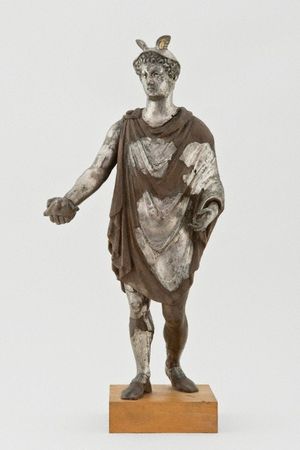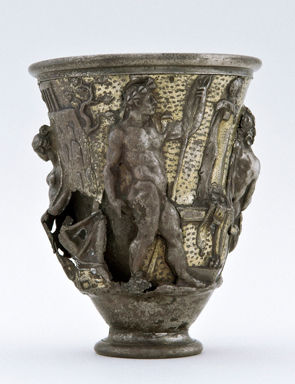Getty Museum Embarks on Conservation Project of Berthouville Treasure
Unknown, Mercury Statuette, 2nd - 3rd century. H: 37.2 cm, Weight: 1.7 kg (14 5/8 in., 3.7478 lb.) VEX.2014.1.2
LOS ANGELES, CA.- The J. Paul Getty Museum announced today that one of the most prominent holdings of the Bibliothèque Nationale de France’s Cabinet des Médailles in Paris, the Berthouville Treasure, has begun a three-year-long process of conservation and technical research at the Getty Villa. This rare cache of approximately 95 ancient Roman silver objects was discovered in March 1830 by a farmer plowing his field near the village of Berthouville in Normandy. An extraordinary group of luxury vessels—including bowls and pitchers, many with figural decoration, as well as two silver statuettes of the Roman god Mercury—the objects are associated with a nearby sanctuary of the god Mercury and date to the first through third centuries A.D. Four large, late antique silver missoria (plates) belonging to the Cabinet are also part of the conservation project.
While undergoing conservation treatment at the Getty Villa, each piece will be individually cleaned and conserved, x-rayed and closely studied in preparation for a new publication on the hoard, and for inclusion in a 2014 exhibition at the Getty Villa of the holdings of ancient Roman luxury goods belonging to the Cabinet.
Jerry Podany, the Getty Museum’s senior conservator of antiquities, said, “We feel extremely fortunate to be able to study and treat such a diverse range of silver objects from the same find site. Following our treatment and conservation efforts, these objects will be better understood, better preserved and available to a wider public.”
Cabinet des Médailles curator Mathilde Avisseau-Broustet, who manages the collection along with curator Cécile Colonna, adds, “We appreciate the unique opportunity to exchange knowledge and expertise with our colleagues at the Getty. Not only will the conservation project help preserve these national treasures, but the findings will also advance art historical research and promote collaborative scholarship between art historians, museum curators, conservators, and scientists.”
New discoveries are already being made on the first of the objects x-rayed in January. Using the most current methods for treating silver artifacts, a recent analysis of two double-walled drinking vessels revealed hidden inscriptions on their interior surface. The inscriptions recorded the weight of the metal used to construct a portion of the object. This precise inventory information demonstrates an acute awareness of the high value of silver used in their manufacture. The x-rays also revealed various restoration materials, which will undergo scientific analysis in the coming year.

/https%3A%2F%2Fprofilepics.canalblog.com%2Fprofilepics%2F1%2F0%2F100183.jpg)
/https%3A%2F%2Fstorage.canalblog.com%2F03%2F02%2F119589%2F96711876_o.jpg)
/https%3A%2F%2Fstorage.canalblog.com%2F11%2F31%2F119589%2F94773502_o.jpg)
/https%3A%2F%2Fstorage.canalblog.com%2F20%2F83%2F119589%2F94772815_o.jpg)
/https%3A%2F%2Fstorage.canalblog.com%2F26%2F72%2F119589%2F75604929_o.jpg)
/https%3A%2F%2Fstorage.canalblog.com%2F59%2F60%2F119589%2F26458628_o.jpg)




/http%3A%2F%2Fstorage.canalblog.com%2F36%2F54%2F119589%2F111149229_o.jpg)
/http%3A%2F%2Fstorage.canalblog.com%2F91%2F49%2F119589%2F76368760_o.jpg)
/http%3A%2F%2Fstorage.canalblog.com%2F79%2F85%2F119589%2F74383196_o.jpg)
/http%3A%2F%2Fstorage.canalblog.com%2F40%2F65%2F119589%2F74195559_o.jpg)